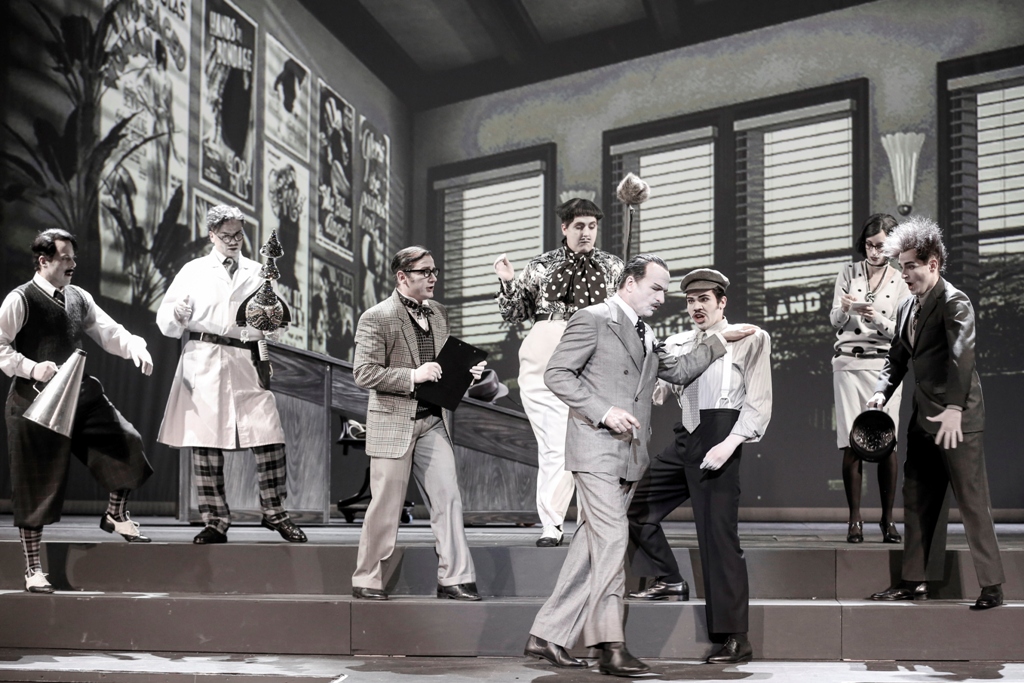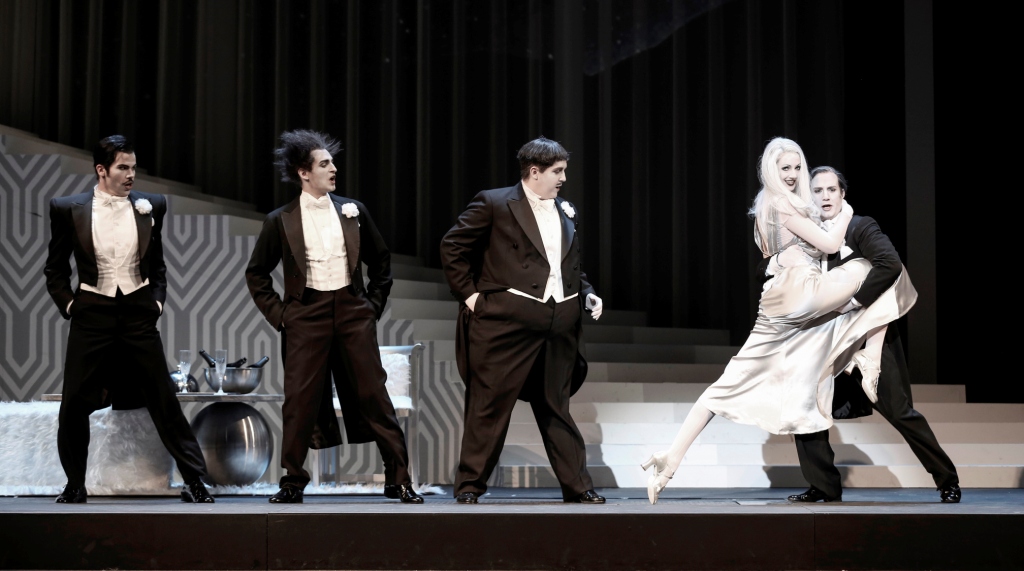John Groves
Operetta Research Center
19 January, 2017
Considering the continuing number of revivals of Im weißen Rössl one could be forgiven for thinking that Benatzky composed nothing else! Yet nothing could be further from the truth: there are many more shows, several of which, like Axel an der Himmelstür/Axel at Heaven’s Gate (1936), were very successful in their time, yet have rarely been revived in living memory.

Zaral Leander together mit Max Hansen, in the original production of “Axel.”
The operetta deals with the fascination that we (or just the media?) had and still have with ‘Hollywood’ and all the romance that the name conjures up, the idea originating with cabaret stars Paul Morgan, Adolf Schulz (who wrote the book) and Hans Weigel (lyrics). Kevin Clarke has written a fascinating article on the history of the operetta, which tells the tale of an up and coming reporter, Axel Swift, desperate enough to do anything for a scoop, especially get an interview with Gloria Mills, film star, who ‘wants to be alone’ and never gives interviews! When he does eventually manage to be alone with her, he is obviously ‘at Heaven’s gate’ – but he is accused of stealing her priceless jewels, before eventually presumably marrying her!

Bettina Mönch as Gloria Mills in “Axel an der Himmelstür.” (Photo: Barbara Pálffy/Volksoper Wien)
Just occasionally, when one visits the theatre, one experiences something which is so superb, it is difficult to imagine it being staged in any other way, or so successfully: it is just perfect! Such is Peter Lund’s production of Axel! Rarely have I come across such detailed, inventive, imaginative ideas that just make directing an operetta look so simple.
The whole production is in black and white – plus a few shades of grey!
That is to say that even the actors’ faces and hands are grey as if everything was a ‘live’ version of a movie before ‘Technicolor’ was invented! Just occasionally, in the most romantic scenes, there is a touch of gold, for example the glorious, flowing gown that Gloria wears in Act 2, and, rarely, the hint of red lipstick, but it is B and W that predominates. In addition, moving cartoon-like projections are used, often with great humor (Axel’s bicycle ride) to help forward the action. Andreas Ivancsics is the highly talented video designer.

Roman Martin (Regisseur), Boris Eder (Theodor Herlinger), Stefan Bischoff (Autor), Jakob Semotan (Aufnahmeleiter), Kurt Schreibmayer (Cecil McScott), Maximilian Klakow (Tonmeister), Johanna Arrouas (Jessie Leyland), Oliver Liebl (Komponist): “Axel an der Himmelstür” in Vienna 2016. (Photo: Barbara Pálffy/Volksoper Wien)
Doria Kornysheva designed the period costumes which are all apt to their particular character, and often lavish: Sam Madwar the ever inventive set designer.
Julia Koci radiates the role of Gloria (as the second cast); she just is a Hollywood star (Garbo?), and knows it! She has a charismatic presence and voice to match, even if she cannot hope to emulate the original 1936 Gloria, Zarah Leander, with her basso profundo!
Andreas Bieber is a wonderful foil to her in the role of Axel: he could have come straight from any 1920s Hollywood ‘B’ movie, and has the necessary energy and lightness of touch for the role. Much of the operetta involves both of them: they spar beautifully off each other and are very funny.
Juliette Khahil is Axel’s supposed fiancée, Jessie, whom of course he doesn’t eventually marry: what could be a two-dimensional role is fleshed out so that we really believe her, and, like Kurt Schriebmayer, who plays the film producer Desmond Carter, both seem to have an instinctive knowledge of the style required for their characters.

Bettina Mönch (Gloria Mills), Hollywood Harmonists: Maximilian Klakow, Oliver Liebl, Jakob Semotan, Stefan Bischoff, Andreas Bieber (Axel Swift) in “Axel an der Himmelstür.” (Photo: Barbara Pálffy/Volksoper Wien)
Most of the other roles are played by the five ‘Hollywood Harmonists’ (Stefan Bischoff, Jakob Semotan, Oliver Liebl, Roman Martin and Maximilian Klakow), who have enormous fun with their various characterizations beginning with ‘In Hollywood’, perhaps the best known song.
The libretto has been slightly revised for the Volksoper production by Peter Lund: it is very amusing and fast-paced (English speaking visitors need not fear that they will not understand the show as every word is super-titled in a clever English translation) always moving the action forward swiftly and ensuring that there is a laugh every few seconds. Some of the musical numbers have been repositioned to great effect – In Hollywood now comes near the start – and everything has been re-orchestrated with great panache by Kai Tietje. The conductor is Lorenz C. Aichner, drawing appropriate 1920s sounds from the pit.

Bettina Mönch (Gloria Mills), Hollywood Harmonists: Maximilian Klakow, Oliver Liebl, Jakob Semotan, Stefan Bischoff. (Photo: Barbara Pálffy/Volksoper Wien)
What of the operetta itself? The plot of this screwball comedy is, to say the least, flimsy but highly entertaining, the music often superb and catchy: there is only one waltz, but to compensate a wonderful languorous blues – ‘Gebundene Hände’. The cumulative effect is light as air. One leaves the theatre with that ‘feel good’ factor which is so rare: in fact a perfect evening!
The program book is well worth acquiring as it contains many period photographs as well as the 1958 recording that Zarah Leander made – though I have enjoyed listening to the Livestream recording of this new production even more!
Any complaints: yes, two! Firstly, that there is so much going on, whether onstage or on screen, it is impossible to take in everything on one visit, so book in advance to see it twice! Secondly, the performance I saw was the final one this season so I am unable to see it again! But, when it is revived, as surely it must be, I’ll be there!
Over the last few years, several operetta directors, namely Barrie Kosky in Berlin, have succeeded in dragging operetta into the 21st century and making it relevant to modern audiences. This production of Axel an der Himmelstür joins the list! A totally superb evening at the theatre, never to be forgotten!
